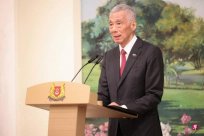Source: Bloomberg
Author: CATARINA SARAIVA
A series of disappointing inflation data has forced the Federal Reserve to re -set the timetable for the first rate cut and re -evaluate the price growth trajectory.
The Fed Chairman Jerom Powell emphasized the information on the week. He said that the confidence needed to get interest rate cuts may require "longer than expected", which shattered the hope of more than two interest rate cuts in 2024.Some people are worried that they may not cut interest rates at all.
"This confirms that the Fed is willing to wait," said Diane Swonk, chief economist of KPMG."People are worried that it is too easy to stimulate the economy, and the demand is still great."
Powell lacks a sense of urgency to adjust interest rates, which is exactly the same as his colleagues.However, the continued strong economic and labor market, and the rebound of the market at the beginning of the year, has also re -triggered discussions on monetary policy restrictions.
Fed officials are increasingly stating that the cost of lending in borrowing may not be enough to suppress demand, which exacerbates the anxiety of investors and analysts that the Fed may need further interest rates.
Most policy makers have clearly stated that interest rates are expected to reach peaks, but some Federal Reserve officials said that if necessary to suppress price growth, they have an open attitude towards this idea.
John Williams, the president of the New York Federal Reserve Bank, said that the current policy is restricted, and he said on Thursday that interest rate hikes are not his baseline expectations.However, he added that if economic data support takes this approach to achieve the Fed's inflation goal, then interest rate hikes are still possible.
Susan Collins, President of Boston Federal Reserve Bank, welcomes the rapid decline in inflation last year in a recent speech, but expressed fearing that if the demand does not cool down, the price will continue to rise.
"This means that demand must slow down the Fed to achieve price stability," Collins said in his speech on April 11."Therefore, although the toughness of economic activities is good news, it has also triggered the position of monetary policy position actually suppressed the problem of demand."
According to the estimated medium value of Bloomberg survey, economists are currently expected to cut interest rates twice this year, less than three expected interest rate cuts in March.
The progress of inflation last year can be largely due to improvement in economic supply: the chaotic supply chain was finally unlocked, and a large number of immigrants poured into help to fill the vacant positions.
At the same time, the demand is still strong.The economy grew rapidly in the second half of 2023.And just last month, retail sales increased by 0.7%, exceeding the expectations of economists.
But because demand is the main channel for monetary policy to play, the continuous demand has triggered questions about policy constraints.
"If you don't know how strong restrictions are, you can almost only wait to see it," said Sarah House, a senior economist in Wells Fargo.




